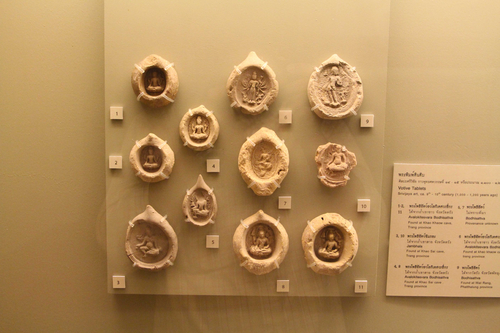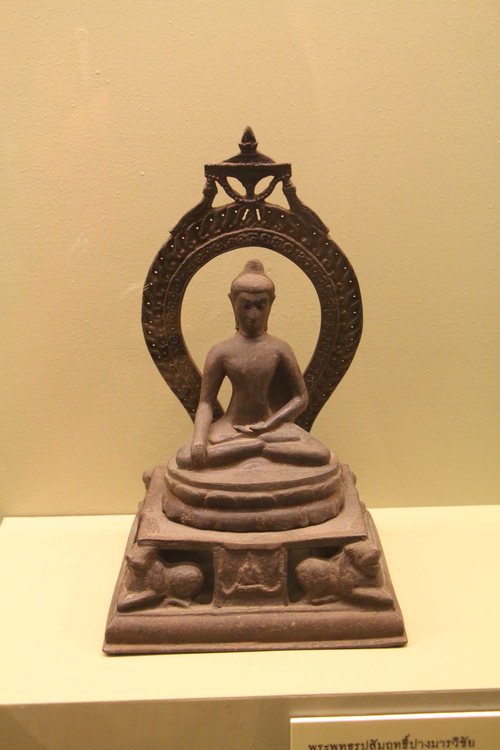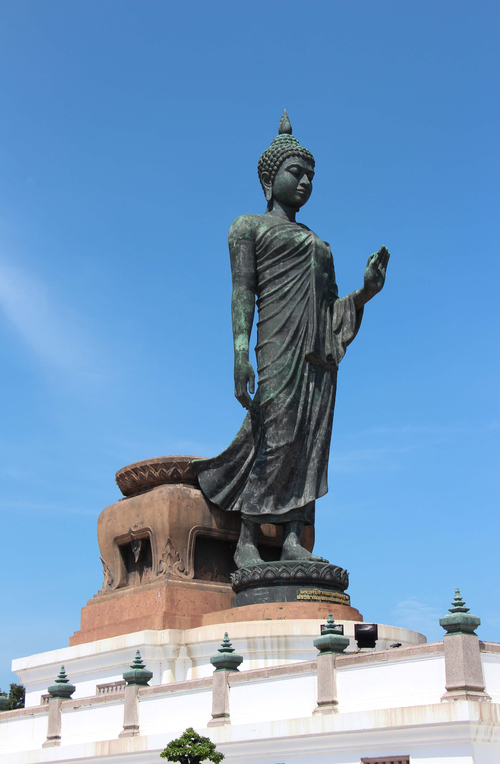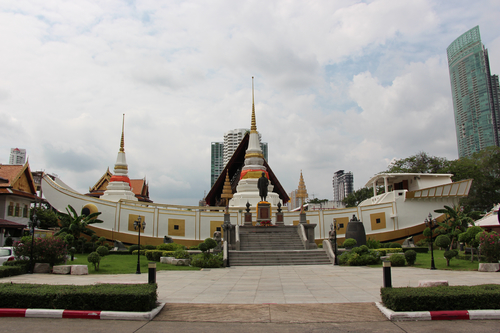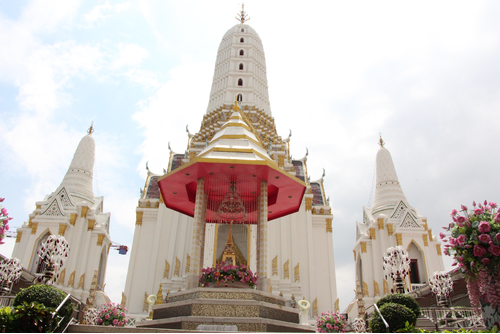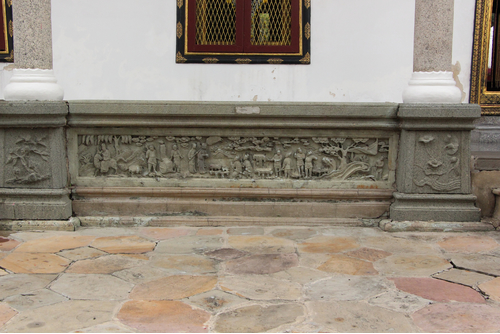ค้นหางานศิลปกรรม
ฐานข้อมูลศิลปกรรมในเอเชียตะวันออกเฉียงใต้
ประติมากรรมพระพิมพ์
พระพิมพ์ดินดิบเหล่านี้ค้นพบจากหลากพื้นที่ในบริเวณภาคใต้ของไทย มีลักษณะเป็นก้อนกลม ส่วนบนยื่นแหลมเล็กน้อย บางองค์อาจทำส่วนล่างยื่นแหลมด้วย ประทับรูปพระโพธิสัตว์ หรือทิพยบุคคลอื่นๆ ไว้ตรงกลาง เช่น พระโพธิสัตว์อวโลกิเตศวร 21 กร พระโพธิสัตว์อวโลกิเตศวร 4 กร ท้าวกุเวรหรือท้าวชัมภละ พระพิมพ์แบบนี้ได้ค้บพบอยู่ตามดินแดนที่นับถือพุทธศาสนามหายาน โดยเพาะอย่างยิ่งราชวงศ์ปาละในประเทศอินเดีย และราชวงศ์ไศเลนทร์ในเกาะชวาประเทศอินโดนีเซีย เป็นหลักฐานแสดงความสัมพันธ์ระหว่างกันผ่านเครือข่ายการนับถือพุทธศาสนามหายาน
ประติมากรรมพระพุทธรูปปางมารวิชัย
พระพุทธรูปนั่งขัดสมาธิเพชร พระหัตถ์ทำปางมารวิชัย รองรับด้วยฐานบัวคว่ำบัวหงายซึ่งวางอยู่บนฐานสี่เหลี่ยมที่ประดับรูปสิงห์อยู่ที่มุม เบื้องหลังเป็นประภามณฑลวงกลม พื้นที่ตรงกลางเจาะโปร่ง ขอบนอกประดับด้วยลายดอกไม้กลมและลายเปลวเพลิง ด้านบนมีฉัตร
ประติมากรรมพระพุทธรูป
พระพุทธรูปอยู่ในสภาพชำรุด พระพักตร์ชำรุดบางส่วน พระกรขวาและพระวรกายตั้งแต่พระชานุ (เข่า) ลงไปสูญหาย พระพุทธรูปยืนตรง พระเกศาขมวดเป็นก้นหอย พระอุษณีษะนูนแต่เพียงเล็กน้อย ทั้งสองสิ่งข้างต้นนี้ทำให้นึกถึงพระพุทธรูปศิลปะอินเดียแบบอมราวดีที่น่าจะเป็นต้นแบบ ครองจีวรห่มเฉียง หนา มีแนวชายจีวรหนาพาดผ่านจากด้านล่างสู่ข้อพระกรซ้าย ซึ่งเป็นสิ่งที่ทำให้นึกถึงพระพุทธรูปอินเดียแบบอมราวดีเช่นกัน ทว่าจีวรกลับเรียบไม่มีริ้วอันแตกต่างไปจากพระพุทธรูปอมราวดีที่ทำริ้วเสมอ พระหัตถ์ขวากำและยกขึ้นระดับพระอุระ หันฝ่าพระหัตถ์เข้าสู่พระองค์
ประติมากรรมพระศรีศากยทศพลญาณประธานพุทธมณฑลสุทรรศน์
พระพุทธรูปลีลาเหนือฐานดอกบัว พระหัตถ์ซ้ายแสดงปางวิตรรกมุทรา พระพักตร์รูปไข่ค่อนข้างกลม คล้ายใบหน้าบุคคลจริง ขมวดพระเกศาเป็นก้นหอย มีอุษณีษะรองรับรัศมีเปลว พระกรรณยาว ครองจีวรห่มเฉียงเป็นริ้วอย่างธรรมชาติ มีสังฆาฏิพาดพระอังสา ชายจีวรละจากพระพุทธบัลลังก์ที่อยู่เบื้องหลังอย่างสมจริง
ประติมากรรมพระพุทธมนุสสนาค
พระพุทธรูปประทับยืนเหนือฐานสิงห์กลีบบัว ที่ฐานมีจารึกพระราชดำริของพระบาทสมเด็จพระปกเกล้าเจ้าอยู่หัวในการสร้างพระพุทธรูป แสดงปางประทานอภัย 2 พระหัตถ์ หรือปางห้ามสมุทร ปลายนิ้วพระหัตถ์ทั้ง 4 ยาวไม่เสมอกัน ครองจีวรห่มคลุมพระอังสาทั้ง 2 ข้าง จีวรเป็นริ้วอย่างธรรมชาติ แลเห็นจีวรที่ห่มทับสบงที่เป็นริ้วชั้นใน รูปแบบของการทำจีวรจึงแสดงถึงแนวคิดอย่างสมจริง แต่พุทธลักษณะอื่นๆยังคงไว้ ได้แก่ พระพักตร์ที่สงบ พระเนตรเหลือบต่ำ พระกรรณยาว ขมวดพระเกศาเป็นเม็ดเล็ก มีอุษณีษะเตี้ยๆรองรับพระรัศมีเปลว เหนือพระเศียรประดับด้วยฉัตรทองฉลุลาย 5 ชั้น
สถาปัตยกรรมสำเภาและเจดีย์ทรงเครื่อง
เรือสำเภาก่ออิฐถือปูน ลักษณะคล้ายเรือสำเภาแต้จิ๋ว หัวเรือหันสู่ทิศใต้ไปสู่ปากแม่น้ำเจ้าพระยา ท้ายเรือหันไปทางทิศเหนือ ห้องท้ายเรือเป็นที่ประดิษฐานพระพุทธรูปและรอยพระพุทธบาท กลางลำเรือประดิษฐานเจดีย์ทรงเครื่องขนาดใหญ่ 1 องค์ และทางหัวเรือประดิษฐานเจดีย์ทรงเครื่องขนาดเล็กกว่าอีก 1 องค์ รูปแบบของเจดีย์ทรงเครื่องประกอบด้วยชุดฐานสิงห์ 3 ฐาน มีบัวทรงคลุ่มรองรับองค์ระฆังเพิ่มมุม ส่วนยอดเป็นบัวทรงคลุ่มเถา ปลี และเม็ดน้ำค้าง เจดีย์ทรงเครื่องเป็นรูปแบบที่มีมาตั้งแต่ในสมัยอยุธยาตอนปลายและเป็นที่นิยมอย่างมากในสมัยรัชกาลที่ 3
สถาปัตยกรรมพระพุทธปรางค์
ปรางค์ 3 องค์ ตั้งอยู่บนฐานไพทีเดียวกัน ส่วนล่างของปรางค์ทั้ง 3 องค์ เป็นชุดฐานบัวลูกแก้วอกไก่ ส่วนเรือนธาตุของปรางค์ประธานเป็นอาคารแบบมณฑปจัตุรมุข ภายนอกมีประติมากรรมยักษ์ยืนกุมกระบองที่มุมย่อย ผนังมุมย่อยประดับกาบพรหมศร หลังคาจัตุรมุขซ้อน 3 ชั้นมุงกระเบื้อง ที่ตำแหน่งช่อฟ้าประดับนกเจ่า ใบระกา และหางหงส์ลดหลั่นลงมาตามลำดับ ส่วนยอดเป็นปรางค์ซ้อน 6 ชั้นประดับกลีบขนุนที่แนบชิดติดกัน มีชั้นเทพนมและยักษ์แบก ปรางค์อีก 2 องค์ที่ขนาบข้างมีรูปแบบเหมือนกัน แตกต่างจากปรางค์ประธานเนื่องจากมีขนาดเล็กกว่า หลังซ้อน 2 ชั้น หน้าบันเป็นสามเหลี่ยมเรียบ ไม่ประดับนกเจ่า ใบระกาและหางหงส์
ประติมากรรมประติมากรรมเรื่องสามก๊ก
ประติมากรรมหินสลักในกรอบรูปสี่เหลี่ยมผืนผ้า เล่าเรื่องราวตอนต่างๆจากวรรณคดีเรื่องสามก๊ก ภาพบุคคลแต่งกายอย่างจีน ภาพทิวทัศน์ประกอบด้วยต้นไม้ ท้องฟ้า ยานพาหนะและสัตว์ เป็นกระบวนลายสลักอย่างจีน
